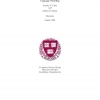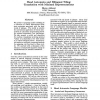100
Voted
ACL
1996
15 years 2 months ago
1996
Under categorial grammars that have powerful rules like composition, a simple n-word sentence can have exponentially many parses. Generating all parses is inefficient and obscures...
68
Voted
ACL
1996
15 years 2 months ago
1996
73
Voted
ACL
1996
15 years 2 months ago
1996
This paper describes a prototype disambiguation module, KANKEI, which was tested on two corpora of the TRAINS project. In ambiguous verb phrases of form V ... NP PP or V ... NP ad...
113
Voted
ACL
1996
15 years 2 months ago
1996
This paper describes a new statistical parser which is based on probabilities of dependencies between head-words in the parse tree. Standard bigram probability estimation techniqu...
78
Voted
ACL
1996
15 years 2 months ago
1996
121
click to vote
ACL
1996
15 years 2 months ago
1996
Lexicalized Tree Adjoining Grammars have proved useful for NLP. However, numerous redundancy problems face LTAGs developers, as highlighted by Vijay-Shanker and Schabes (92). We p...
117
Voted
ACL
1996
15 years 2 months ago
1996
In this paper 1 we present a new parsing algorithm for linear indexed grammars (LIGs) in the same spirit as the one described in (Vijay-Shanker and Weir, 1993) for tree adjoining ...
131
Voted
ACL
1996
15 years 2 months ago
1996
We use a statistical method to select the most probable structure or parse for a given sentence. It takes as input the dependency structures generated for the sentence by a depend...
91
Voted
ACL
1996
15 years 2 months ago
1996
\Prose rhythm" is a widely observed but scarcely quanti ed phenomenon. We describe an information-theoretic model for measuring the regularity of lexical stress in English te...
135
Voted
ACL
1996
15 years 2 months ago
1996
We present a language model consisting of a collection of costed bidirectional finite state automata associated with the head words of phrases. The model is suitable for increment...



